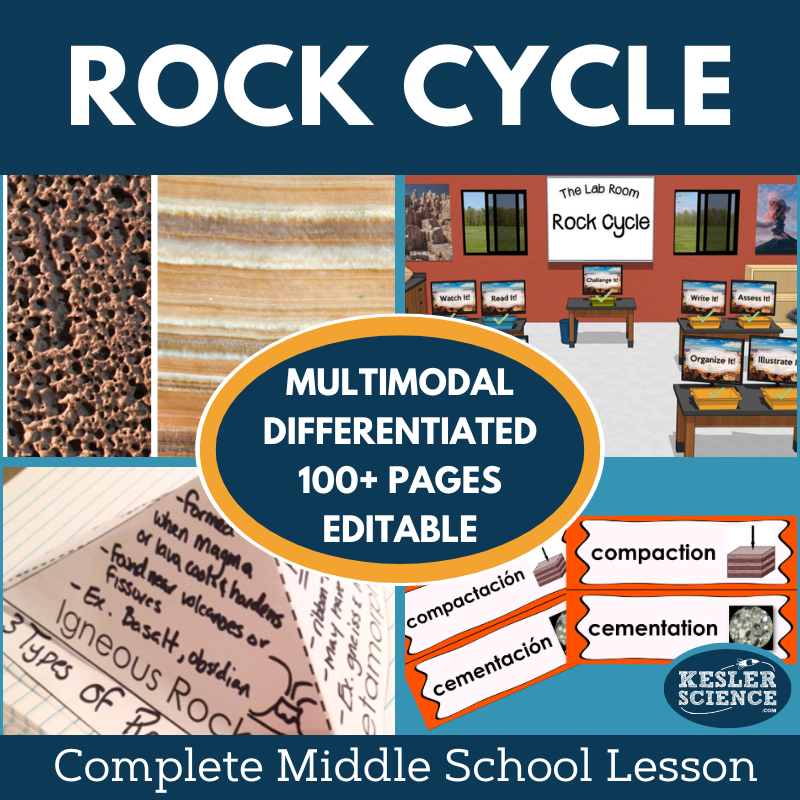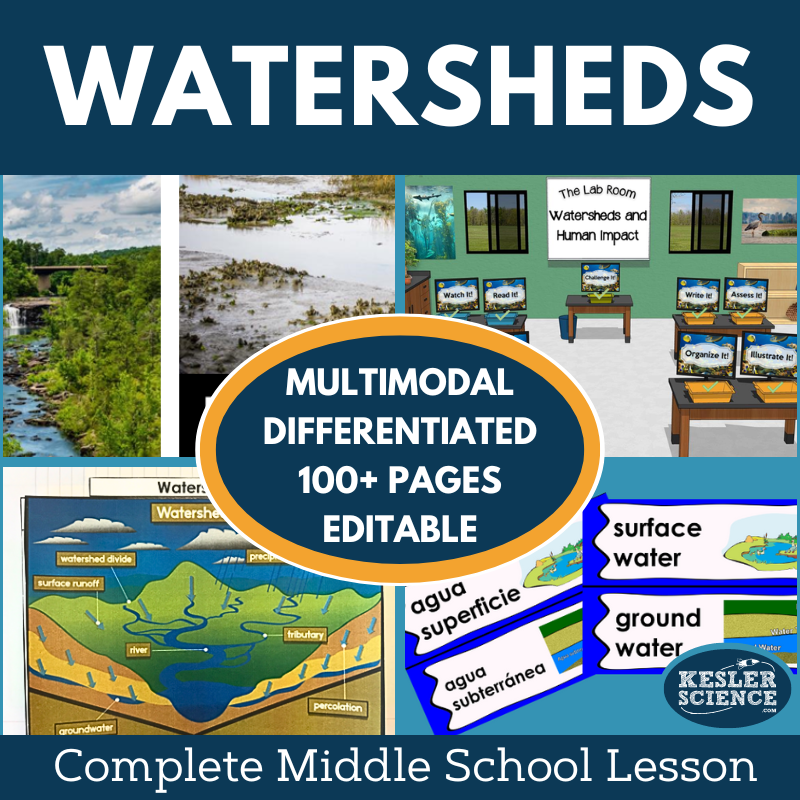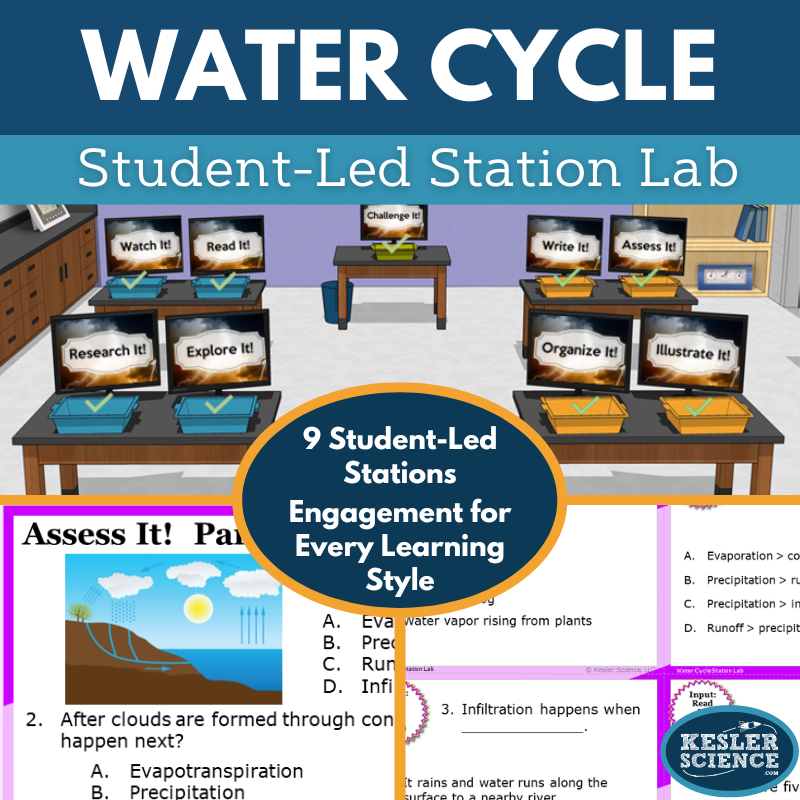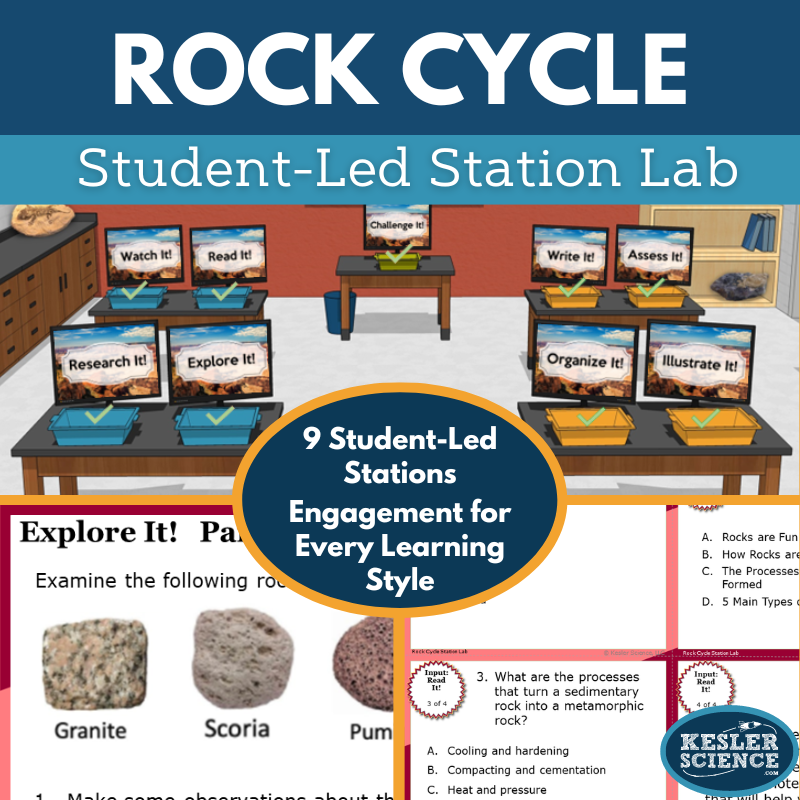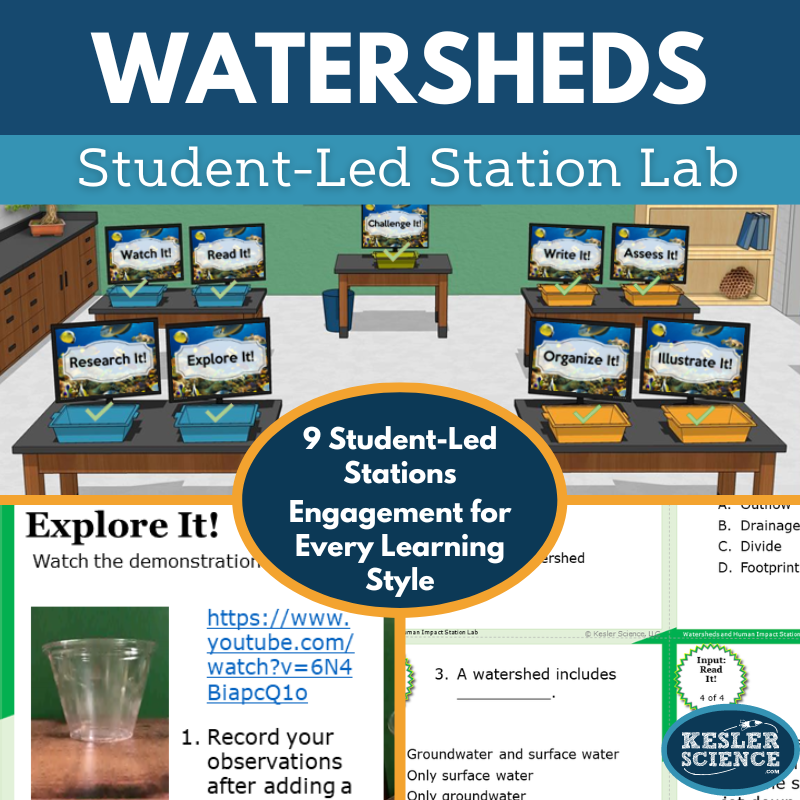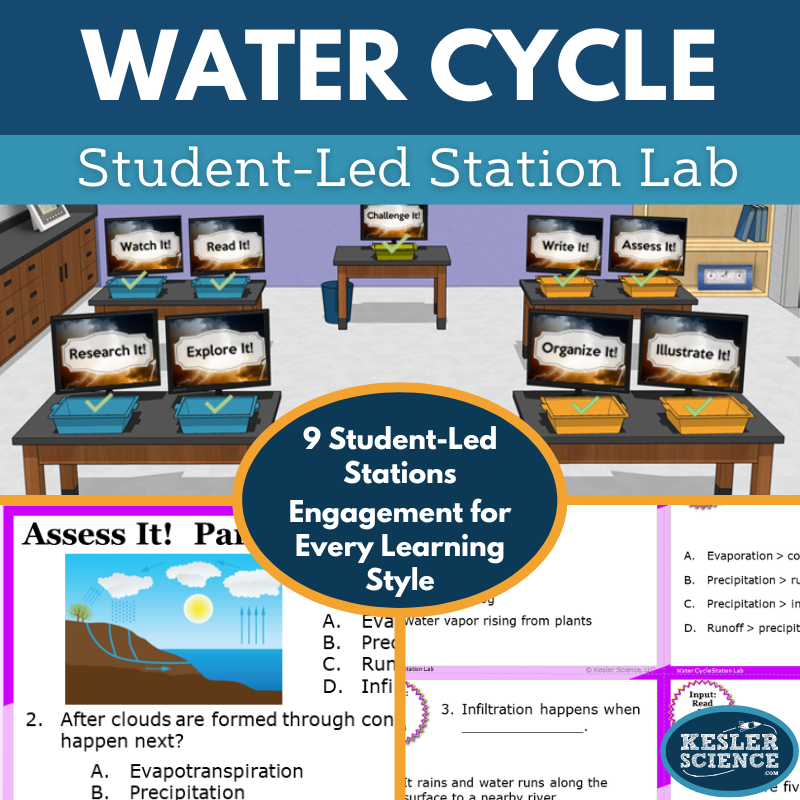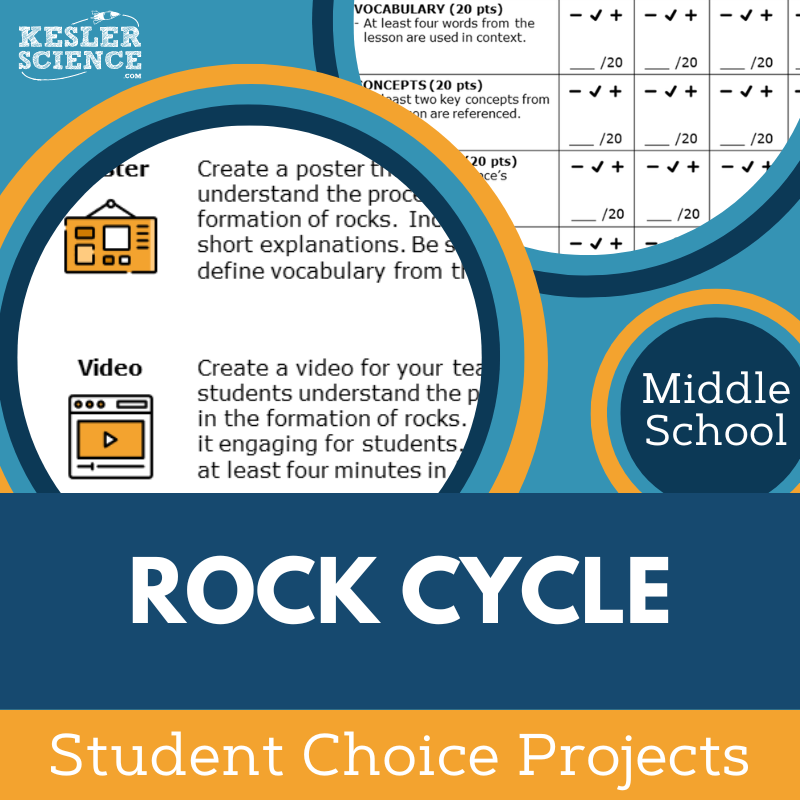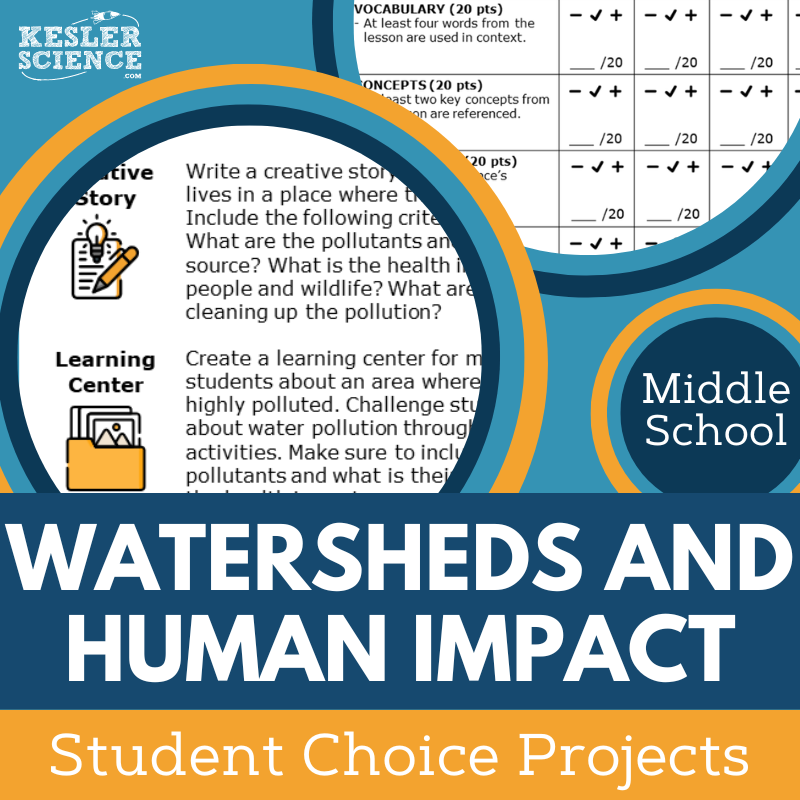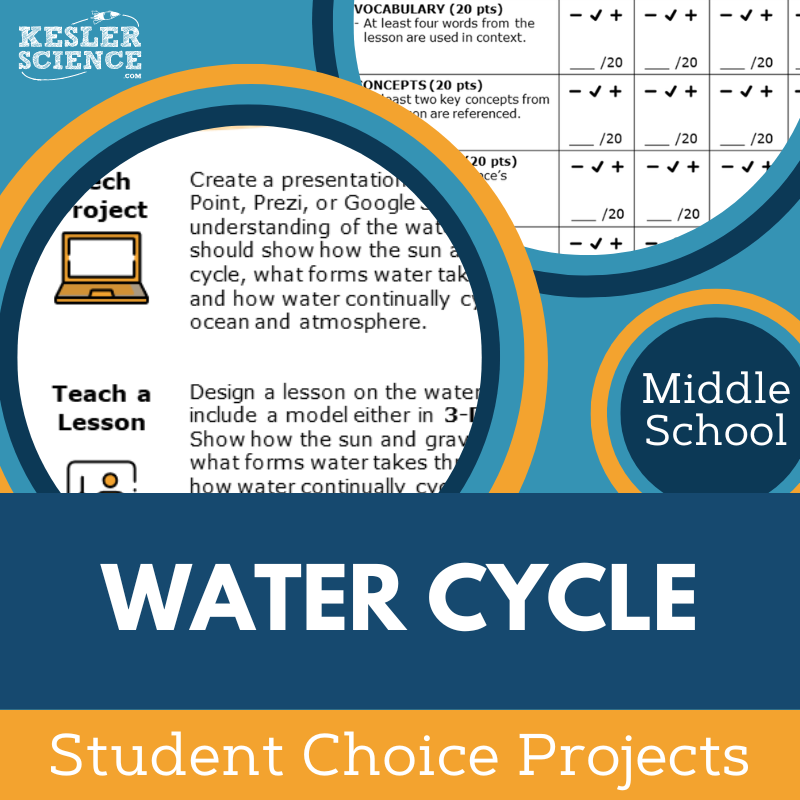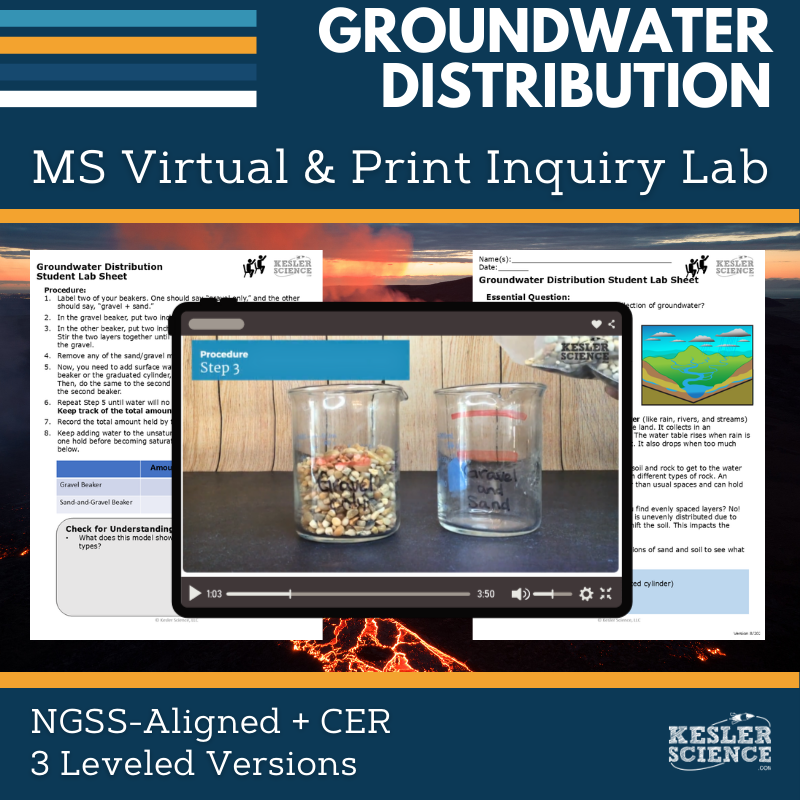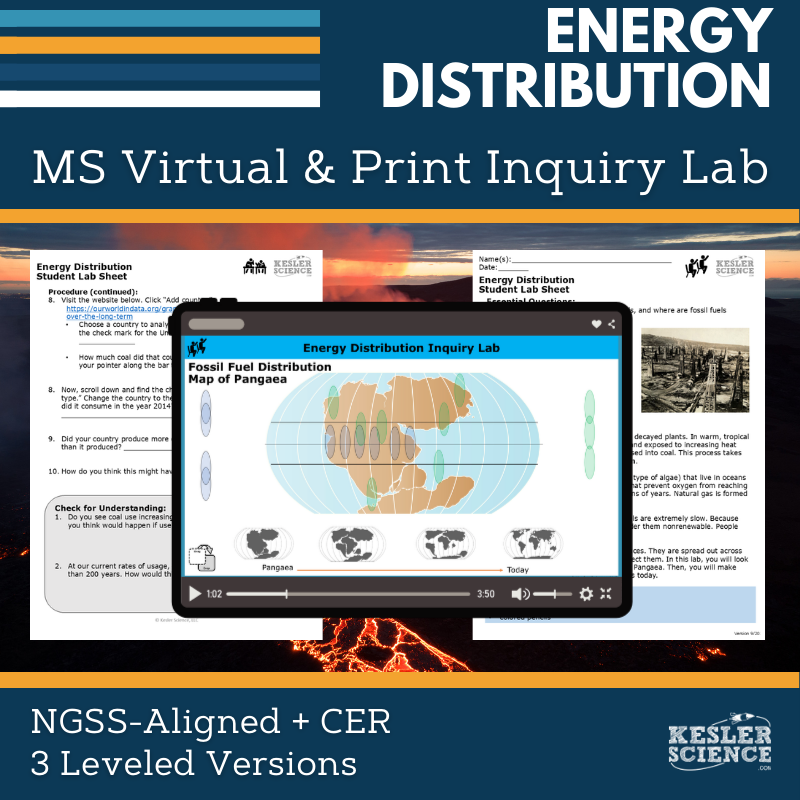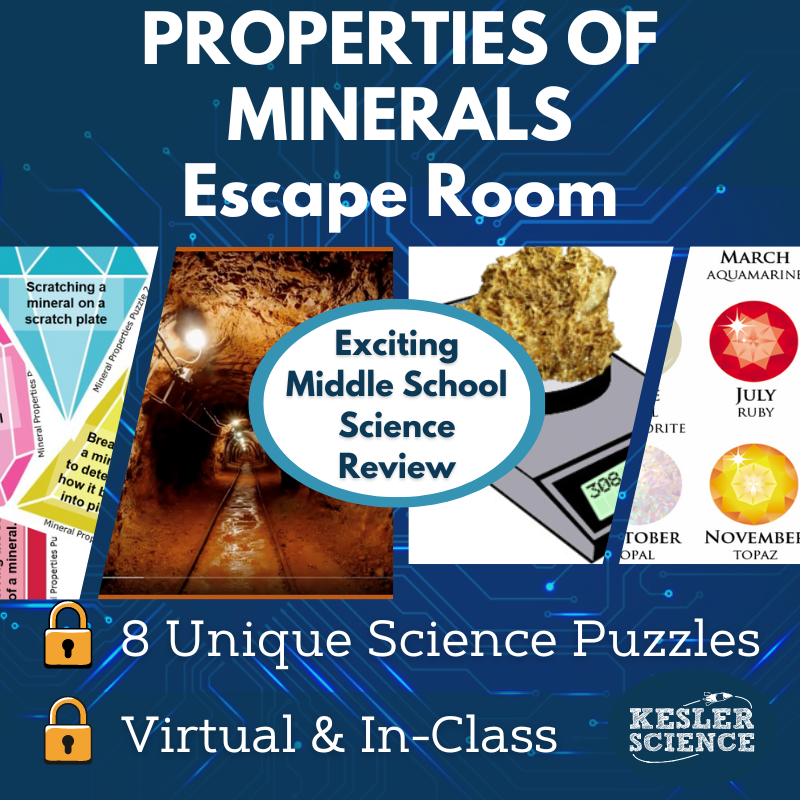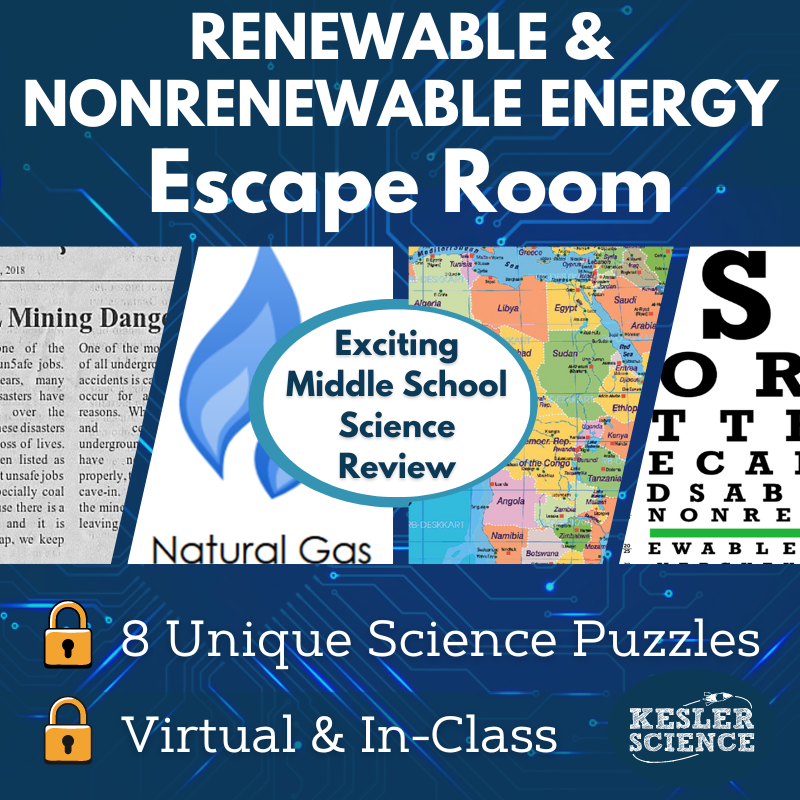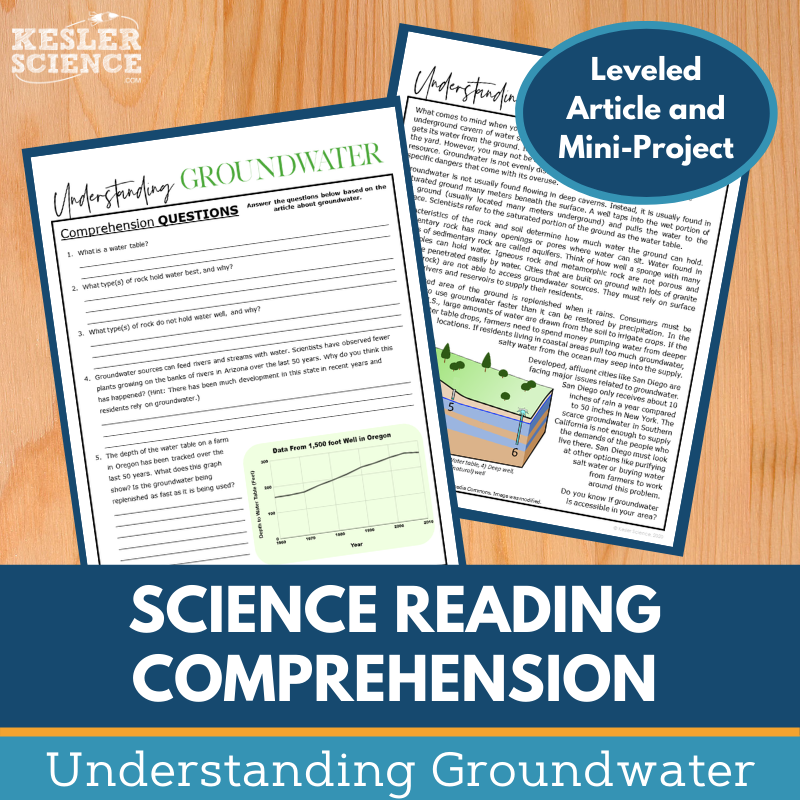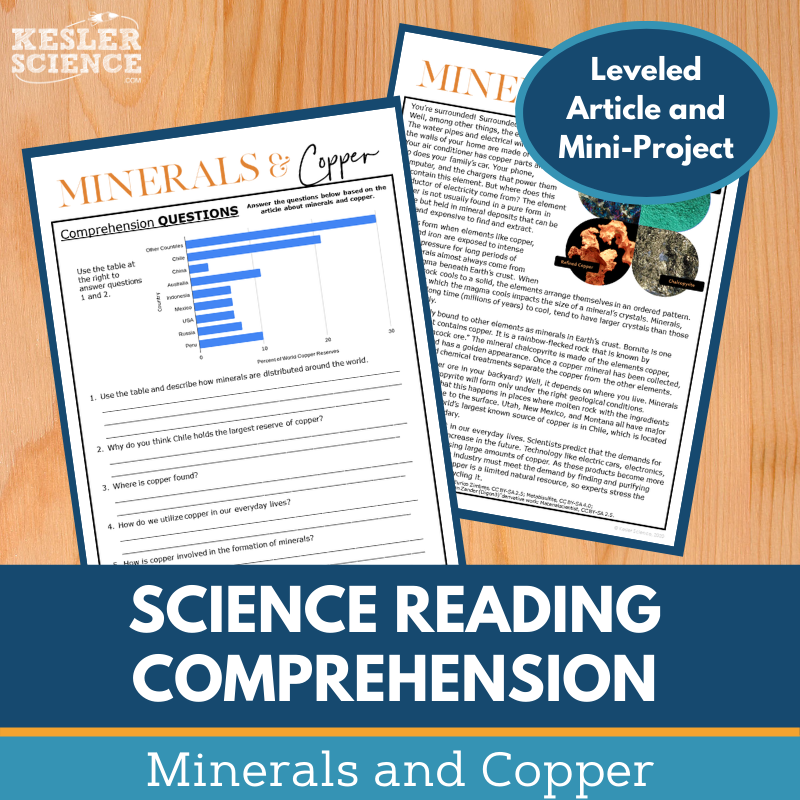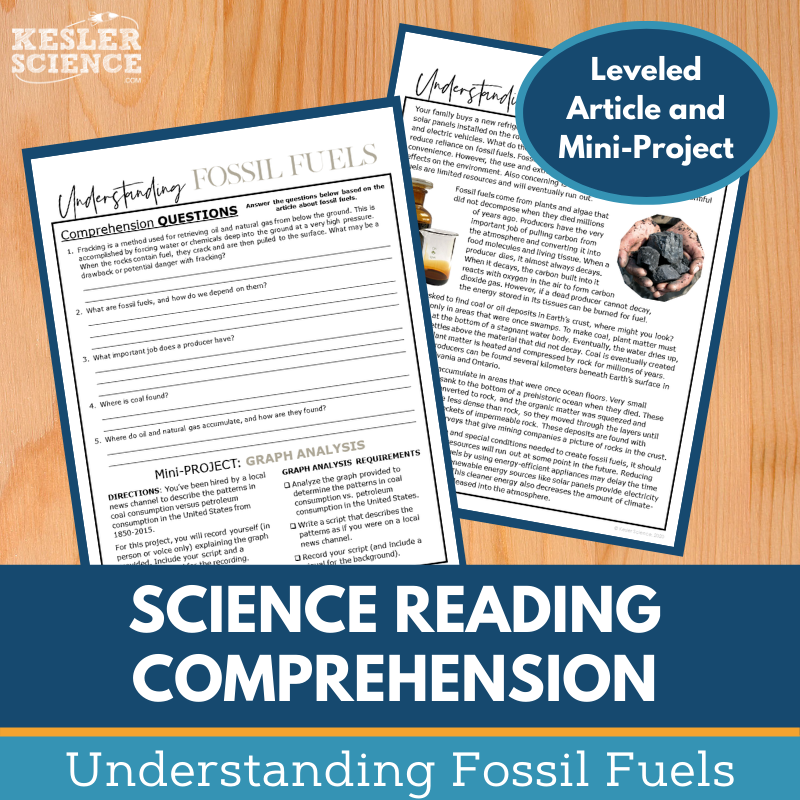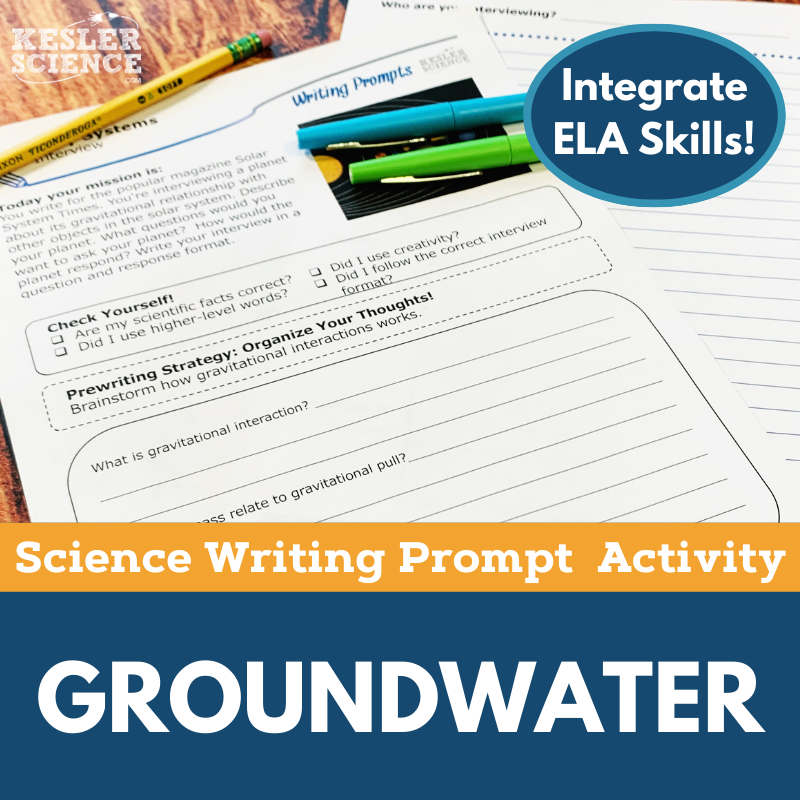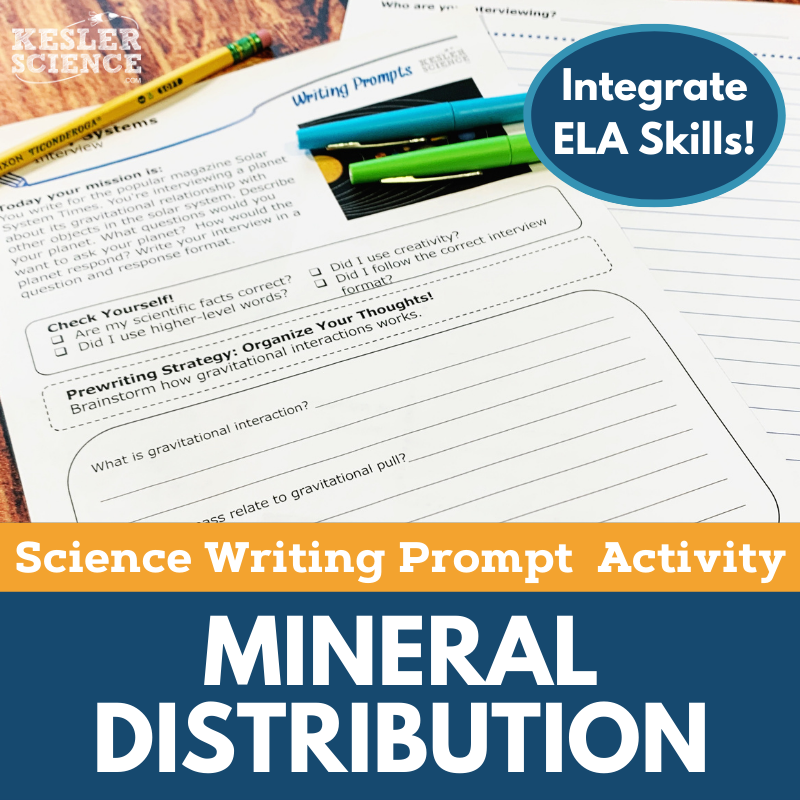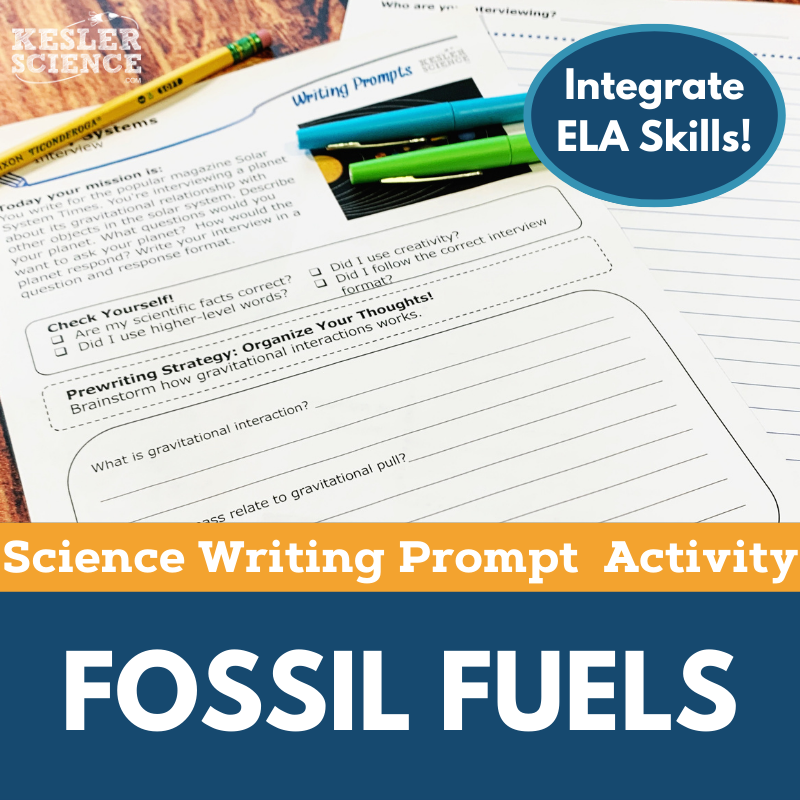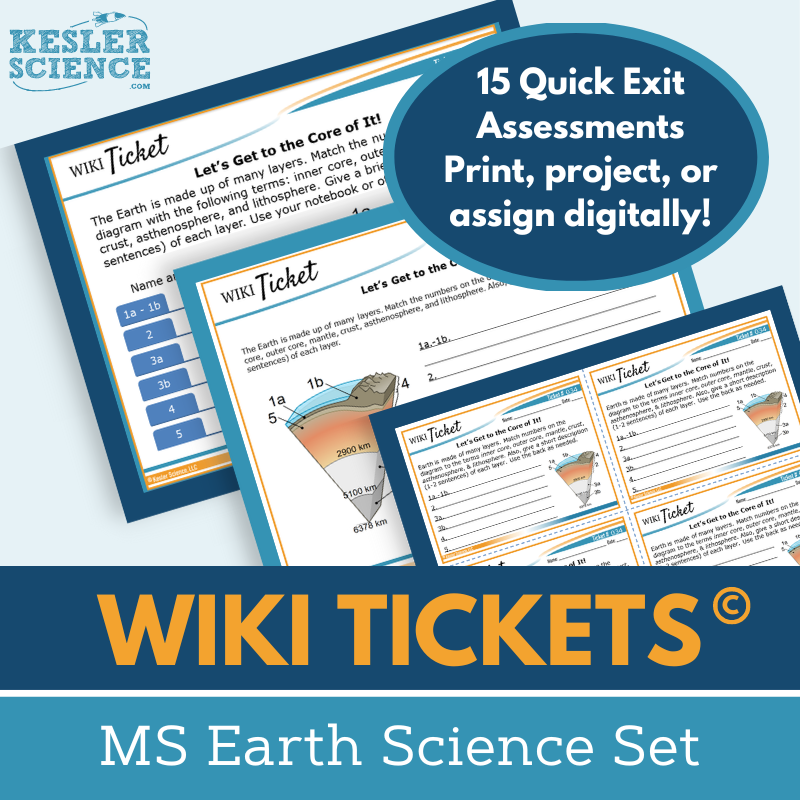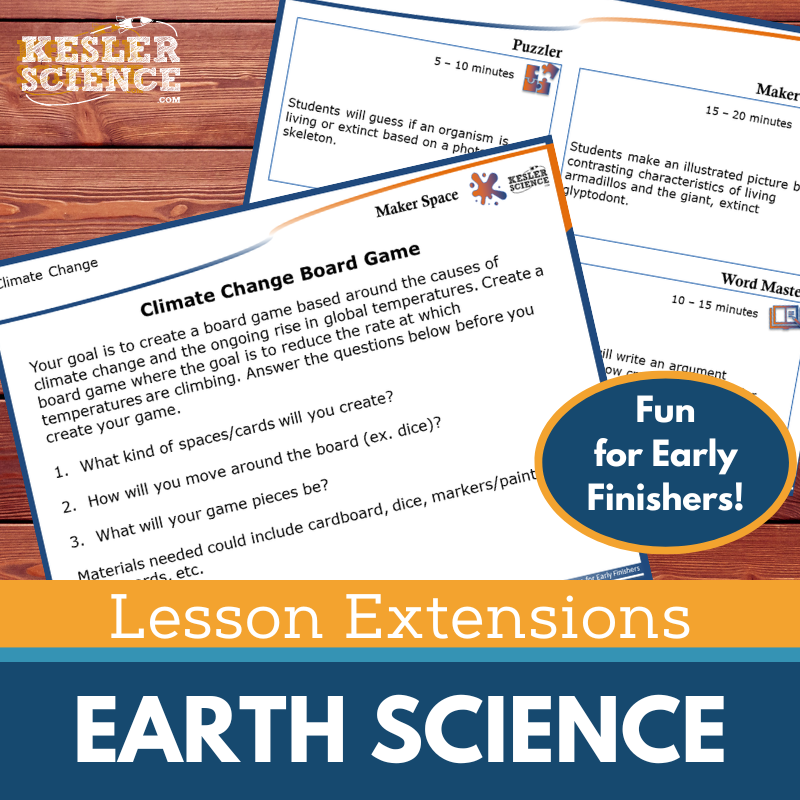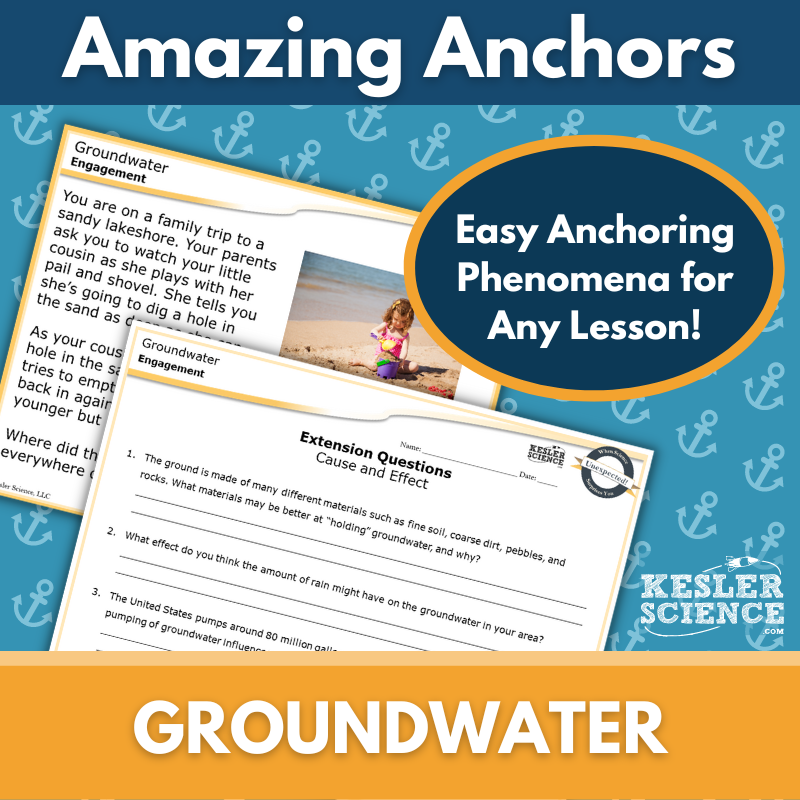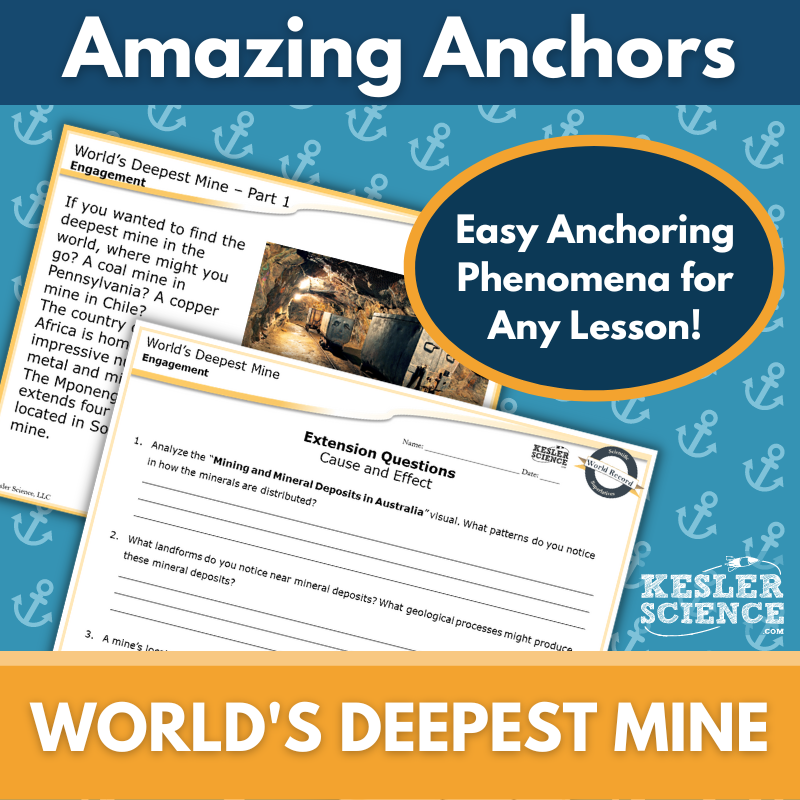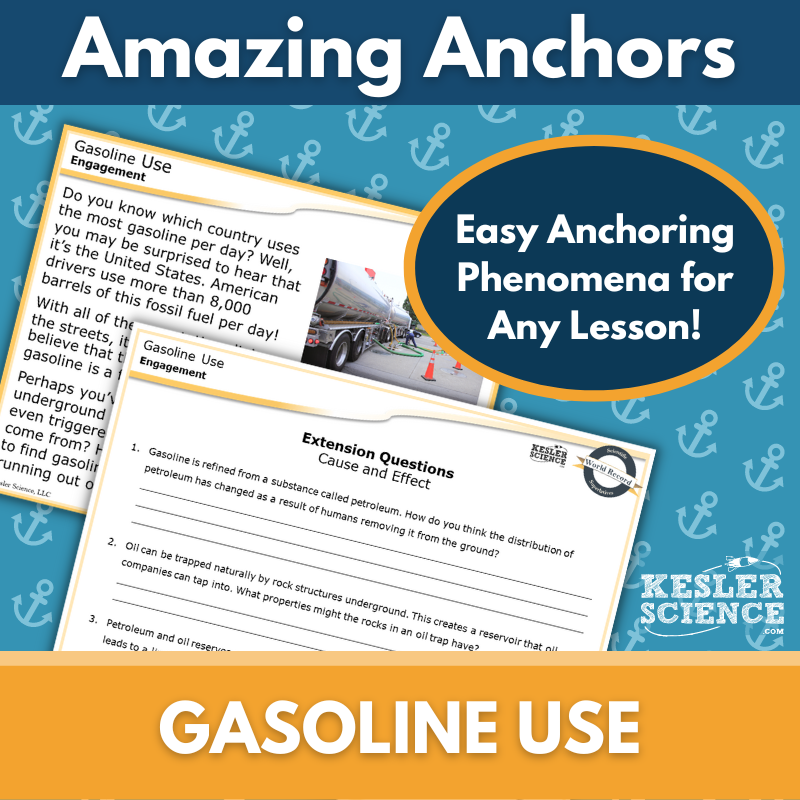Earth's Resource Distribution Activities for Middle School Science
The Kesler Science 5E Lessons provide comprehensive, student-led units for middle school classrooms, covering the rock cycle, watersheds, and the water cycle through engaging, differentiated activities. The resources below will give students a comprehensive understanding of Earth's resource distribution. All of the following materials are also included in the Kesler Science Membership.
The Kesler Science Rock Cycle 5E Lesson is a comprehensive, student-led unit designed for middle school classrooms. It includes editable presentations, worksheets, choice projects, and assessments, requiring minimal prep while supporting differentiated learning. The lesson explores the formation and classification of metamorphic, sedimentary, and igneous rocks, aligning with NGSS and TEKS standards.
Following the 5E Model, the unit provides engaging activities for each phase. The Engagement section includes objectives, word wall cards, and class discussion prompts. Exploration features a differentiated station lab with multimodal input and output stations, offering hands-on experiments, reading passages in English and Spanish, research tasks, videos, and interactive categorization activities. Explanation includes editable PowerPoints, interactive notebooks, and note-taking templates. Elaboration allows students to extend learning through choice projects, while Evaluation provides STAAR 2.0-aligned assessments, review questions, and worksheets.
Designed for maximum flexibility, the lesson is available in both print and digital formats and includes Spanish translations for key materials. It is adaptable for in-person and virtual learning environments, ensuring accessibility for all students.
The Kesler Science Rock Cycle 5E Lesson is a comprehensive, student-led unit designed for middle school classrooms. It includes editable presentations, worksheets, choice projects, and assessments, requiring minimal prep while supporting differentiated learning. The lesson explores the formation and classification of metamorphic, sedimentary, and igneous rocks, aligning with NGSS and TEKS standards.
Following the 5E Model, the unit provides engaging activities for each phase. The Engagement section includes objectives, word wall cards, and class discussion prompts. Exploration features a differentiated station lab with multimodal input and output stations, offering hands-on experiments, reading passages in English and Spanish, research tasks, videos, and interactive categorization activities. Explanation includes editable PowerPoints, interactive notebooks, and note-taking templates. Elaboration allows students to extend learning through choice projects, while Evaluation provides STAAR 2.0-aligned assessments, review questions, and worksheets.
Designed for maximum flexibility, the lesson is available in both print and digital formats and includes Spanish translations for key materials. It is adaptable for in-person and virtual learning environments, ensuring accessibility for all students.
The Kesler Science Watersheds 5E Lesson provides a comprehensive middle school unit covering essential watershed concepts through differentiated, student-led activities. Designed around the proven 5E instructional model (Engagement, Exploration, Explanation, Elaboration, Evaluation), it includes editable presentations, interactive notebooks, worksheets, assessments, and choice projects suitable for classroom or virtual learning.
Students explore the differences between fresh and salt water, examples of surface and groundwater, aquifer components, water pollution, and conservation strategies. The unit features multimodal resources such as differentiated station labs, interactive activities, reading passages, videos, card sorts, and Spanish translations for inclusive learning. Assessments align with STAAR 2.0 standards, ensuring readiness for testing.
The Kesler Science Watersheds 5E Lesson provides a comprehensive middle school unit covering essential watershed concepts through differentiated, student-led activities. Designed around the proven 5E instructional model (Engagement, Exploration, Explanation, Elaboration, Evaluation), it includes editable presentations, interactive notebooks, worksheets, assessments, and choice projects suitable for classroom or virtual learning.
Students explore the differences between fresh and salt water, examples of surface and groundwater, aquifer components, water pollution, and conservation strategies. The unit features multimodal resources such as differentiated station labs, interactive activities, reading passages, videos, card sorts, and Spanish translations for inclusive learning. Assessments align with STAAR 2.0 standards, ensuring readiness for testing.
The Kesler Science Water Cycle 5E Lesson is a comprehensive, student-led unit designed for middle school learners. It includes editable presentations, worksheets, choice projects, and assessments, all requiring minimal prep. The lesson explores how water cycles through land, oceans, and the atmosphere, its various forms, and the roles of the Sun and gravity in the process.
The unit follows the 5E Model, integrating differentiated, multimodal learning. Engagement activities include objectives, word wall cards, and interactive class discussions. Exploration features a hands-on, student-led station lab with nine stations, incorporating reading, research, video analysis, hands-on experiments, and creative expression. Explanation provides editable PowerPoints, interactive notebooks in English and Spanish, and structured note-taking templates. Elaboration allows students to extend learning through choice projects, while Evaluation includes STAAR 2.0-aligned assessments, discussion questions, and practice worksheets.
This resource is available in both print and digital formats, with Spanish translations of key materials. It is fully adaptable for virtual learning, ensuring flexibility in any instructional setting.
The Kesler Science Water Cycle 5E Lesson is a comprehensive, student-led unit designed for middle school learners. It includes editable presentations, worksheets, choice projects, and assessments, all requiring minimal prep. The lesson explores how water cycles through land, oceans, and the atmosphere, its various forms, and the roles of the Sun and gravity in the process.
The unit follows the 5E Model, integrating differentiated, multimodal learning. Engagement activities include objectives, word wall cards, and interactive class discussions. Exploration features a hands-on, student-led station lab with nine stations, incorporating reading, research, video analysis, hands-on experiments, and creative expression. Explanation provides editable PowerPoints, interactive notebooks in English and Spanish, and structured note-taking templates. Elaboration allows students to extend learning through choice projects, while Evaluation includes STAAR 2.0-aligned assessments, discussion questions, and practice worksheets.
This resource is available in both print and digital formats, with Spanish translations of key materials. It is fully adaptable for virtual learning, ensuring flexibility in any instructional setting.
Engage your middle school students with this student-led Rock Cycle Station Lab, designed to encourage independent learning while minimizing prep time. Through interactive stations, students will classify rocks based on their formation processes, deepening their understanding of the rock cycle.
This differentiated, modular lab includes nine stations that provide a mix of input and output activities. Students explore new concepts through hands-on demonstrations, research, reading passages (available in English and Spanish), and videos. They demonstrate their understanding by organizing information, illustrating models, writing responses, and completing assessments. A challenge station offers extension activities for early finishers.
With all necessary materials, signage, and task cards included, students can work independently or in small groups. The lab is adaptable for in-class and virtual learning, making it a versatile resource for your earth science curriculum.
Engage your middle school students with this student-led Rock Cycle Station Lab, designed to encourage independent learning while minimizing prep time. Through interactive stations, students will classify rocks based on their formation processes, deepening their understanding of the rock cycle.
This differentiated, modular lab includes nine stations that provide a mix of input and output activities. Students explore new concepts through hands-on demonstrations, research, reading passages (available in English and Spanish), and videos. They demonstrate their understanding by organizing information, illustrating models, writing responses, and completing assessments. A challenge station offers extension activities for early finishers.
With all necessary materials, signage, and task cards included, students can work independently or in small groups. The lab is adaptable for in-class and virtual learning, making it a versatile resource for your earth science curriculum.
Engage your classroom with this student-led station lab aligned to NGSS standards, designed to explore watersheds through an interactive, modular approach suitable for in-class or virtual learning. Students actively identify and compare watershed characteristics by independently rotating through eight differentiated stations featuring videos, readings, research, and hands-on activities, with an additional ninth challenge station providing extension tasks for early finishers.
At input stations, students explore watersheds through practical demonstrations, online research, differentiated reading passages available in English and Spanish, and informative videos. Output stations enable students to demonstrate their understanding by organizing information, creating visual illustrations, responding to writing prompts, and completing assessments that reinforce key vocabulary. This resource fosters personalized, student-directed learning while minimizing teacher preparation.
Engage your classroom with this student-led station lab aligned to NGSS standards, designed to explore watersheds through an interactive, modular approach suitable for in-class or virtual learning. Students actively identify and compare watershed characteristics by independently rotating through eight differentiated stations featuring videos, readings, research, and hands-on activities, with an additional ninth challenge station providing extension tasks for early finishers.
At input stations, students explore watersheds through practical demonstrations, online research, differentiated reading passages available in English and Spanish, and informative videos. Output stations enable students to demonstrate their understanding by organizing information, creating visual illustrations, responding to writing prompts, and completing assessments that reinforce key vocabulary. This resource fosters personalized, student-directed learning while minimizing teacher preparation.
Engage your middle school students with this student-led Water Cycle Station Lab, designed for active learning and minimal teacher prep. This hands-on lesson guides students to explore how water cycles through land, ocean, and atmosphere, the forms water takes, and the role of the Sun and gravity in the process.
Students engage with nine differentiated stations that offer multimodal learning experiences, including hands-on experiments, research, reading comprehension, videos, and interactive activities. They demonstrate understanding by organizing information, illustrating models, writing responses, and completing assessments. A challenge station provides extension activities for advanced learners.
This flexible resource includes all necessary signage, literature, resources, and task cards for independent or small-group learning. Available in both English and Spanish, it supports in-class and virtual learning, making science accessible and engaging for all students.
Engage your middle school students with this student-led Water Cycle Station Lab, designed for active learning and minimal teacher prep. This hands-on lesson guides students to explore how water cycles through land, ocean, and atmosphere, the forms water takes, and the role of the sun and gravity in the process.
Students engage with nine differentiated stations that offer multimodal learning experiences, including hands-on experiments, research, reading comprehension, videos, and interactive activities. They demonstrate understanding by organizing information, illustrating models, writing responses, and completing assessments. A challenge station provides extension activities for advanced learners.
This flexible resource includes all necessary signage, literature, resources, and task cards for independent or small-group learning. Available in both English and Spanish, it supports in-class and virtual learning, making science accessible and engaging for all students.
The Rock Cycle Student Choice Projects lesson aligns with NGSS science standards, allowing middle school students to select a project that fits their preferred output style. A project page outlines six student-led options plus a “design your own” project, all with an editable rubric for teacher, peer, or self-assessment.
These flexible, multimodal projects provide creative ways for students to demonstrate their understanding. Two versions of the project page support differentiation, with modified options for students needing remediation and challenge options for advanced learners. Teachers can adjust the rubric to fit grading needs.
The projects use standard classroom supplies like paper, markers, and scissors, and many options are available for digital completion.
The Rock Cycle Student Choice Projects lesson aligns with NGSS science standards, allowing middle school students to select a project that fits their preferred output style. A project page outlines six student-led options plus a “design your own” project, all with an editable rubric for teacher, peer, or self-assessment.
These flexible, multimodal projects provide creative ways for students to demonstrate their understanding. Two versions of the project page support differentiation, with modified options for students needing remediation and challenge options for advanced learners. Teachers can adjust the rubric to fit grading needs.
The projects use standard classroom supplies like paper, markers, and scissors, and many options are available for digital completion.
This Watersheds and Human Impact Student Choice Projects lesson aligns with NGSS science standards, allowing middle school students to select a project matching their preferred output style. A project page provides nine student-led project options plus a "design your own" choice, accompanied by an editable rubric for teacher, peer, or self-assessment.
The flexible and multimodal nature of these projects supports creative, personalized demonstrations of student understanding. Differentiation is provided through two versions of the project page, including modified options to support remediation and combination options to challenge advanced learners. The editable rubric assesses vocabulary, concepts, presentation, clarity, and accuracy, and can be adjusted to suit individual grading preferences.
Projects utilize standard classroom supplies such as paper, markers, and scissors, with many tasks also suitable for digital completion.
This Watersheds and Human Impact Student Choice Projects lesson aligns with NGSS science standards, allowing middle school students to select a project matching their preferred output style. A project page provides nine student-led project options plus a "design your own" choice, accompanied by an editable rubric for teacher, peer, or self-assessment.
The flexible and multimodal nature of these projects supports creative, personalized demonstrations of student understanding. Differentiation is provided through two versions of the project page, including modified options to support remediation and combination options to challenge advanced learners. The editable rubric assesses vocabulary, concepts, presentation, clarity, and accuracy, and can be adjusted to suit individual grading preferences.
Projects utilize standard classroom supplies such as paper, markers, and scissors, with many tasks also suitable for digital completion.
The Water Cycle Student Choice Projects align with NGSS standards, allowing middle school students to demonstrate their understanding through a project that matches their preferred output style. A project page outlines six student-led options plus a “design your own” project, with an editable rubric for teacher, peer, or self-assessment.
These flexible, multimodal projects provide creative ways for students to engage with the material. Two versions of the project page support differentiation, with modified options for students needing remediation and challenge opportunities for advanced learners. Teachers can adjust the rubric to fit their grading needs.
The projects require standard classroom supplies like paper, markers, and scissors, with many options available for digital completion. Some crafting materials may be helpful for model-building projects.
The Water Cycle Student Choice Projects align with NGSS standards, allowing middle school students to demonstrate their understanding through a project that matches their preferred output style. A project page outlines six student-led options plus a “design your own” project, with an editable rubric for teacher, peer, or self-assessment.
These flexible, multimodal projects provide creative ways for students to engage with the material. Two versions of the project page support differentiation, with modified options for students needing remediation and challenge opportunities for advanced learners. Teachers can adjust the rubric to fit their grading needs.
The projects require standard classroom supplies like paper, markers, and scissors, with many options available for digital completion. Some crafting materials may be helpful for model-building projects.
The Groundwater Distribution Inquiry Lab aligns with NGSS MS-ESS3-1, guiding students to explore how geologic features impact groundwater collection. Students will test different combinations of sand and soil to determine which holds the most water.
This lab offers both a hands-on print version and an interactive digital format, including a virtual demonstration with a pre-recorded video. Each version includes comprehension questions, Claim-Evidence-Reasoning (C.E.R.) prompts, and reflection sections. Differentiation is built in with three levels: dependent (guided), modified (structured), and independent (student-led).
The print format provides a step-by-step experiment requiring common lab materials like beakers, gravel, sand, and water. The digital format, compatible with Google Slides and learning platforms, includes a video walkthrough for students to follow along without physical materials.
Additional features include editable PowerPoints, multimodal learning support, teacher resource pages, answer keys, and flexible digital and printable formats to accommodate diverse classroom needs.
The Groundwater Distribution Inquiry Lab aligns with NGSS MS-ESS3-1, guiding students to explore how geologic features impact groundwater collection. Students will test different combinations of sand and soil to determine which holds the most water.
This lab offers both a hands-on print version and an interactive digital format, including a virtual demonstration with a pre-recorded video. Each version includes comprehension questions, Claim-Evidence-Reasoning (C.E.R.) prompts, and reflection sections. Differentiation is built in with three levels: dependent (guided), modified (structured), and independent (student-led).
The print format provides a step-by-step experiment requiring common lab materials like beakers, gravel, sand, and water. The digital format, compatible with Google Slides and learning platforms, includes a video walkthrough for students to follow along without physical materials.
Additional features include editable PowerPoints, multimodal learning support, teacher resource pages, answer keys, and flexible digital and printable formats to accommodate diverse classroom needs.
The Mineral Distribution Inquiry Lab aligns with the NGSS MS-ESS3-1 standard, guiding students to construct scientific explanations for why minerals are unevenly distributed due to geological processes. This resource includes both hands-on and fully virtual formats, providing maximum flexibility for classroom implementation.
Students will investigate geological processes influencing mineral locations and create Epsom salt crystals through an engaging experiment or interactive digital demonstration. Each format features comprehension questions, claim-evidence-reasoning (CER) prompts, and reflective questions to deepen understanding.
Differentiation is integrated through three distinct lab versions: dependent (guided for on-level learners), modified (highly structured with additional supports), and independent (student-led for advanced learners). Teachers can easily customize editable PowerPoint files, compatible with Google Slides.
The print lab requires standard classroom materials like Epsom salt, plastic cups, hot water, measuring cups, internet-connected devices for research, and refrigerator access. The digital version includes a recorded lab procedure and interactive virtual activities, ideal for remote learning or absent students. Comprehensive teacher resources and answer keys simplify planning and assessment.
The Mineral Distribution Inquiry Lab aligns with the NGSS MS-ESS3-1 standard, guiding students to construct scientific explanations for why minerals are unevenly distributed due to geological processes. This resource includes both hands-on and fully virtual formats, providing maximum flexibility for classroom implementation.
Students will investigate geological processes influencing mineral locations and create Epsom salt crystals through an engaging experiment or interactive digital demonstration. Each format features comprehension questions, claim-evidence-reasoning (CER) prompts, and reflective questions to deepen understanding.
Differentiation is integrated through three distinct lab versions: dependent (guided for on-level learners), modified (highly structured with additional supports), and independent (student-led for advanced learners). Teachers can easily customize editable PowerPoint files, compatible with Google Slides.
The print lab requires standard classroom materials like Epsom salt, plastic cups, hot water, measuring cups, internet-connected devices for research, and refrigerator access. The digital version includes a recorded lab procedure and interactive virtual activities, ideal for remote learning or absent students. Comprehensive teacher resources and answer keys simplify planning and assessment.
The Energy Distribution Inquiry Lab aligns with NGSS MS-ESS3-1, engaging students in exploring the geoscience processes responsible for forming fossil fuels and their distribution on Earth. Students will predict and model potential fossil fuel locations using evidence-based reasoning.
This resource includes both digital interactive activities and printable hands-on experiments, providing flexibility to suit various classroom needs. Each format offers comprehension questions, Claim-Evidence-Reasoning (CER) prompts, and reflection sections to reinforce scientific understanding.
Differentiation is seamlessly integrated with three distinct lab versions: Dependent (moderately guided for on-level students), Modified (highly structured with additional support), and Independent (student-led, ideal for advanced learners). Teachers can edit materials in PowerPoint or Google Slides for customized classroom instruction.
The print format uses basic materials like Pangaea and world maps provided in the student packets, along with colored pencils. The digital version requires no additional materials and is suitable for platforms like Google Slides, MS Teams, Schoology, and Canvas.
Teacher resource pages, comprehensive answer keys, and editable student pages simplify lesson preparation and implementation, ensuring an engaging and effective learning experience.
The Energy Distribution Inquiry Lab aligns with NGSS MS-ESS3-1, engaging students in exploring the geoscience processes responsible for forming fossil fuels and their distribution on Earth. Students will predict and model potential fossil fuel locations using evidence-based reasoning.
This resource includes both digital interactive activities and printable hands-on experiments, providing flexibility to suit various classroom needs. Each format offers comprehension questions, Claim-Evidence-Reasoning (CER) prompts, and reflection sections to reinforce scientific understanding.
Differentiation is seamlessly integrated with three distinct lab versions: Dependent (moderately guided for on-level students), Modified (highly structured with additional support), and Independent (student-led, ideal for advanced learners). Teachers can edit materials in PowerPoint or Google Slides for customized classroom instruction.
The print format uses basic materials like Pangaea and world maps provided in the student packets, along with colored pencils. The digital version requires no additional materials and is suitable for platforms like Google Slides, MS Teams, Schoology, and Canvas.
Teacher resource pages, comprehensive answer keys, and editable student pages simplify lesson preparation and implementation, ensuring an engaging and effective learning experience.
The Minerals Escape Room is an engaging, hands-on activity that allows students to demonstrate their understanding of mineral properties in a fun and interactive way. Designed to align with NGSS MS-ESS3-1, this escape room challenges students to test physical properties such as hardness, color, luster, and streak while exploring the distribution of Earth's mineral resources.
Teachers have full control over the experience, selecting from eight independent puzzles to fit different class lengths. The activity can be conducted using simple materials like manila envelopes or enhanced with locks and storage boxes for a more authentic escape room setup. A digital version is available through PowerPoint or Google Slides, allowing students to solve puzzles by answering questions and manipulating images. A printable version is also included for at-home use.
This resource provides everything needed for implementation, including teacher directions, answer keys, a digital answer sheet via Google Forms, video challenges, printable props, reward templates, and editable materials. With engaging puzzles and fun completion signs, students will be fully immersed in this exciting learning experience.
The Minerals Escape Room is an engaging, hands-on activity that allows students to demonstrate their understanding of mineral properties in a fun and interactive way. Designed to align with NGSS MS-ESS3-1, this escape room challenges students to test physical properties such as hardness, color, luster, and streak while exploring the distribution of Earth's mineral resources.
Teachers have full control over the experience, selecting from eight independent puzzles to fit different class lengths. The activity can be conducted using simple materials like manila envelopes or enhanced with locks and storage boxes for a more authentic escape room setup. A digital version is available through PowerPoint or Google Slides, allowing students to solve puzzles by answering questions and manipulating images. A printable version is also included for at-home use.
This resource provides everything needed for implementation, including teacher directions, answer keys, a digital answer sheet via Google Forms, video challenges, printable props, reward templates, and editable materials. With engaging puzzles and fun completion signs, students will be fully immersed in this exciting learning experience.
The Energy Escape Room is an interactive, student-centered activity that allows students to demonstrate their knowledge of renewable and nonrenewable energy resources. Designed specifically for NGSS standards, this escape room engages students in evaluating the advantages and disadvantages of various energy types and examining their environmental impacts.
Teachers have complete control over the selection and sequence of the eight independent puzzles, making the activity adaptable to various class durations. It can be facilitated simply using manila envelopes and provided printables, or through an authentic lock-and-box setup requiring a lockout hasp, numeric locks, and a storage box.
The escape room also offers digital options, including a Single Student Digital Version available in PowerPoint or Google Slides for virtual learning, as well as a printable version for students to complete at home.
Included with the escape room are detailed teacher directions, answer keys, an editable teacher version, a digital Google Form answer sheet, and engaging extras such as a video introduction, printable puzzle props, prize ideas, reward templates, and customizable photo signs. This immersive experience ensures students are actively engaged while mastering key concepts related to energy resources.
The Energy Escape Room is an interactive, student-centered activity that allows students to demonstrate their knowledge of renewable and nonrenewable energy resources. Designed specifically for NGSS standards, this escape room engages students in evaluating the advantages and disadvantages of various energy types and examining their environmental impacts.
Teachers have complete control over the selection and sequence of the eight independent puzzles, making the activity adaptable to various class durations. It can be facilitated simply using manila envelopes and provided printables, or through an authentic lock-and-box setup requiring a lockout hasp, numeric locks, and a storage box.
The escape room also offers digital options, including a Single Student Digital Version available in PowerPoint or Google Slides for virtual learning, as well as a printable version for students to complete at home.
Included with the escape room are detailed teacher directions, answer keys, an editable teacher version, a digital Google Form answer sheet, and engaging extras such as a video introduction, printable puzzle props, prize ideas, reward templates, and customizable photo signs. This immersive experience ensures students are actively engaged while mastering key concepts related to energy resources.
This Groundwater Science Reading Comprehension lesson helps students explore Earth's water resources and human impact. Designed for middle school, the leveled passage supports science literacy and reading comprehension.
Students read a nonfiction article about groundwater, answer five to seven comprehension questions, and create a hands-on model demonstrating groundwater use. The resource includes two Lexile-leveled articles (1100-1300), a Cornell notes template, and engaging visuals that print well in grayscale.
Perfect for virtual or in-person learning, the passage is compatible with Google Classroom, MS Teams, Schoology, and Canvas. It works well for sub plans, extra credit, ISS, or whole-class instruction, fostering critical thinking and classroom discussions while reinforcing key science concepts.
This Groundwater Science Reading Comprehension lesson helps students explore Earth's water resources and human impact. Designed for middle school, the leveled passage supports science literacy and reading comprehension.
Students read a nonfiction article about groundwater, answer five to seven comprehension questions, and create a hands-on model demonstrating groundwater use. The resource includes two Lexile-leveled articles (1100-1300), a Cornell notes template, and engaging visuals that print well in grayscale.
Perfect for virtual or in-person learning, the passage is compatible with Google Classroom, MS Teams, Schoology, and Canvas. It works well for sub plans, extra credit, ISS, or whole-class instruction, fostering critical thinking and classroom discussions while reinforcing key science concepts.
This Earth and Human Activity Science Reading Comprehension Lesson introduces students to minerals and copper through a nonfiction article designed to boost science literacy and reading comprehension in middle school students.
It includes two leveled articles (Lexile 1100-1300), each accompanied by five to seven comprehension questions, an interactive mini-project, and an optional Cornell notes template. The colorful graphics are print-friendly and suitable for grayscale printing.
This versatile resource supports both in-person and virtual learning environments, with digital files compatible with Google Classroom, MS Teams, Schoology, and Canvas, allowing students to respond directly within a PPT or Google Slides format.
Ideal for whole-class lessons, sub plans, extra credit, absent students, or ISS, this lesson encourages critical thinking, promotes classroom discussion, and develops textual analysis skills.
The Earth and Human Activity Science Reading Comprehension Lesson introduces students to minerals and copper through a nonfiction article designed to boost science literacy and reading comprehension in middle school students.
It includes two leveled articles (Lexile 1100-1300), each accompanied by five to seven comprehension questions, an interactive mini-project, and an optional Cornell notes template. The colorful graphics are print-friendly and suitable for grayscale printing.
This versatile resource supports both in-person and virtual learning environments, with digital files compatible with Google Classroom, MS Teams, Schoology, and Canvas, allowing students to respond directly within a PPT or Google Slides format.
Ideal for whole-class lessons, sub plans, extra credit, absent students, or ISS, this lesson encourages critical thinking, promotes classroom discussion, and develops textual analysis skills.
The Understanding Fossil Fuels Science Reading Comprehension Lesson helps middle school students explore fossil fuels through an engaging nonfiction article. Students will answer comprehension questions and complete a graph analysis comparing coal and petroleum consumption in the United States.
The resource includes two leveled reading passages (Lexile 1100-1300) with five to seven comprehension questions, an interactive mini-project, and an optional Cornell notes template. Designed for classroom or virtual learning environments like Google Classroom, MS Teams, Schoology, and Canvas, this lesson fosters critical thinking, textual analysis, and science literacy. It’s ideal for sub plans, extra credit, ISS, absent students, or whole-class instruction, encouraging meaningful classroom discussions and enhancing students’ reading comprehension skills.
The Understanding Fossil Fuels Science Reading Comprehension Lesson helps middle school students explore fossil fuels through an engaging nonfiction article. Students will answer comprehension questions and complete a graph analysis comparing coal and petroleum consumption in the United States.
The resource includes two leveled reading passages (Lexile 1100-1300) with five to seven comprehension questions, an interactive mini-project, and an optional Cornell notes template. Designed for classroom or virtual learning environments like Google Classroom, MS Teams, Schoology, and Canvas, this lesson fosters critical thinking, textual analysis, and science literacy. It’s ideal for sub plans, extra credit, ISS, absent students, or whole-class instruction, encouraging meaningful classroom discussions and enhancing students’ reading comprehension skills.
The Groundwater Science Writing Prompt Activity engages middle school students in testing their earth science knowledge through a call-to-action writing exercise. Designed to extend science reasoning and exploration, this activity fosters creativity and engagement both in the classroom and in virtual learning environments.
Aligned with NGSS MS-ESS3-1, students construct scientific explanations based on evidence, exploring how Earth's mineral, energy, and groundwater resources result from past and current geoscience processes. This low-prep, student-centered resource works well for elaboration, review, and cross-curricular integration.
This resource includes teacher directions with an answer guide, project ideas, and rubrics; projection and print handouts in both full-sized and half-sheet formats; and a digital interactive version in PowerPoint, compatible with Google Slides for in-person or remote learning. It can be used as a pre-test assessment, student choice project, enrichment for early finishers, extra credit, make-up work, or differentiation exercise.
Ideal for classroom display or student anthologies, this writing prompt assumes students have prior knowledge of groundwater science or access to research materials.
The Groundwater Science Writing Prompt Activity engages middle school students in testing their earth science knowledge through a call-to-action writing exercise. Designed to extend science reasoning and exploration, this activity fosters creativity and engagement both in the classroom and in virtual learning environments.
Aligned with NGSS MS-ESS3-1, students construct scientific explanations based on evidence, exploring how Earth's mineral, energy, and groundwater resources result from past and current geoscience processes. This low-prep, student-centered resource works well for elaboration, review, and cross-curricular integration.
This resource includes teacher directions with an answer guide, project ideas, and rubrics; projection and print handouts in both full-sized and half-sheet formats; and a digital interactive version in PowerPoint, compatible with Google Slides for in-person or remote learning. It can be used as a pre-test assessment, student choice project, enrichment for early finishers, extra credit, make-up work, or differentiation exercise.
Ideal for classroom display or student anthologies, this writing prompt assumes students have prior knowledge of groundwater science or access to research materials.
The Mineral Distribution Science Writing Prompt Activity engages middle school students in creative narrative writing to reinforce their understanding of Earth’s mineral distribution. Aligned with NGSS MS-ESS3-1, this student-centered, low-prep activity enhances science reasoning and exploration while supporting both classroom and virtual learning.
The resource includes teacher directions with an answer guide, project ideas, and rubrics; projection-friendly prompts; full-sized printable handouts featuring writing prompts, student self-checks, and pre-writing strategies; half-sheet handouts ideal for interactive notebooks or journals; and a digital PowerPoint version compatible with Google Slides.
Perfect as a cross-curricular activity, formative assessment, student-choice project, elaboration for early finishers, extra credit, make-up work, TELPAS samples, or differentiation exercises, this writing prompt encourages creativity, engagement, and scientific literacy. Completed student work can be displayed on bulletin boards or compiled into anthologies, making this activity a versatile addition to your science curriculum.
The Mineral Distribution Science Writing Prompt Activity engages middle school students in creative narrative writing to reinforce their understanding of Earth’s mineral distribution. Aligned with NGSS MS-ESS3-1, this student-centered, low-prep activity enhances science reasoning and exploration while supporting both classroom and virtual learning.
The resource includes teacher directions with an answer guide, project ideas, and rubrics; projection-friendly prompts; full-sized printable handouts featuring writing prompts, student self-checks, and pre-writing strategies; half-sheet handouts ideal for interactive notebooks or journals; and a digital PowerPoint version compatible with Google Slides.
Perfect as a cross-curricular activity, formative assessment, student-choice project, elaboration for early finishers, extra credit, make-up work, TELPAS samples, or differentiation exercises, this writing prompt encourages creativity, engagement, and scientific literacy. Completed student work can be displayed on bulletin boards or compiled into anthologies, making this activity a versatile addition to your science curriculum.
The Fossil Fuels Science Writing Prompt Activity engages middle school students in writing a persuasive essay to demonstrate their understanding of fossil fuels and Earth science concepts. Aligned with NGSS MS-ESS3-1, this low-prep, student-centered resource supports scientific reasoning and can be effectively used for virtual or in-person learning.
This activity includes teacher directions with an answer guide, project ideas, and rubrics; projection slides for whole-class instruction; printable full-sized handouts with prompts, self-checks, pre-writing strategies, and layout templates; and half-sheet versions suitable for interactive notebooks. A digital PowerPoint version compatible with Google Slides allows easy assignment for remote or classroom use.
Ideal for cross-curricular activities, pre-test assessments, student-choice projects, differentiation, extra credit, make-up assignments, TELPAS samples, or enrichment for early finishers. The final essays can be displayed on bulletin boards or compiled into a student anthology. Prior knowledge or access to research materials is recommended.
The Fossil Fuels Science Writing Prompt Activity engages middle school students in writing a persuasive essay to demonstrate their understanding of fossil fuels and Earth science concepts. Aligned with NGSS MS-ESS3-1, this low-prep, student-centered resource supports scientific reasoning and can be effectively used for virtual or in-person learning.
This activity includes teacher directions with an answer guide, project ideas, and rubrics; projection slides for whole-class instruction; printable full-sized handouts with prompts, self-checks, pre-writing strategies, and layout templates; and half-sheet versions suitable for interactive notebooks. A digital PowerPoint version compatible with Google Slides allows easy assignment for remote or classroom use.
Ideal for cross-curricular activities, pre-test assessments, student-choice projects, differentiation, extra credit, make-up assignments, TELPAS samples, or enrichment for early finishers. The final essays can be displayed on bulletin boards or compiled into a student anthology. Prior knowledge or access to research materials is recommended.
The WIKI Tickets© Earth Science Set provides engaging and flexible formative assessments for 6th-8th grade science. This set includes 15 topics, each available in five formats: a full-screen display for projection, three printable handout sizes, and an interactive digital version compatible with PowerPoint and Google Slides.
Aligned with NGSS and TEKS standards, these assessments cover key topics such as ecoregions in Texas, human impact on the environment and natural resources, plate tectonics, the rock cycle, and watersheds. Some standards include multiple tickets, ensuring comprehensive coverage. A bonus table of contents file is included to show standard alignment.
Designed for both in-person and virtual learning, WIKI Tickets© can be used as exit tickets, bellringers, or quick checks. Students can respond on printed handouts, their own paper, or digitally in a 1:1 setting. These colorful assessments make it easy to gauge student understanding in any learning environment.
The WIKI Tickets© Earth Science Set provides engaging and flexible formative assessments for 6th-8th grade science. This set includes 15 topics, each available in five formats: a full-screen display for projection, three printable handout sizes, and an interactive digital version compatible with PowerPoint and Google Slides.
Aligned with NGSS and TEKS standards, these assessments cover key topics such as ecoregions in Texas, human impact on the environment and natural resources, plate tectonics, the rock cycle, and watersheds. Some standards include multiple tickets, ensuring comprehensive coverage. A bonus table of contents file is included to show standard alignment.
Designed for both in-person and virtual learning, WIKI Tickets© can be used as exit tickets, bellringers, or quick checks. Students can respond on printed handouts, their own paper, or digitally in a 1:1 setting. These colorful assessments make it easy to gauge student understanding in any learning environment.
Lesson Extensions provide engaging, student-choice activities designed to challenge fast finishers and enrich their understanding of earth science. These rigorous yet enjoyable activities fill downtime, reinforce critical thinking, and encourage independent learning aligned with NGSS and TEKS standards.
Each extension includes four interactive components: Puzzler for problem-solving, Maker Space for hands-on STEAM activities, Tech Connection for digital media demonstrations, and Word Master for creative science writing. Teacher directions, answer keys, and both projection and print versions (full- and half-sheet sizes) are included, making these extensions ideal for lesson wrap-ups, enrichment periods, or independent exploration.
Topics covered include circulation and climate, climate change, Earth's changing surface, fossil fuel distribution, the geological time scale, the plate tectonic theory, rock formation, weather changes, and more, ensuring comprehensive earth science enrichment.
Lesson Extensions provide engaging, student-choice activities designed to challenge fast finishers and enrich their understanding of earth science. These rigorous yet enjoyable activities fill downtime, reinforce critical thinking, and encourage independent learning aligned with NGSS and TEKS standards.
Each extension includes four interactive components: Puzzler for problem-solving, Maker Space for hands-on STEAM activities, Tech Connection for digital media demonstrations, and Word Master for creative science writing. Teacher directions, answer keys, and both projection and print versions (full- and half-sheet sizes) are included, making these extensions ideal for lesson wrap-ups, enrichment periods, or independent exploration.
Topics covered include circulation and climate, climate change, Earth's changing surface, fossil fuel distribution, the geological time scale, the plate tectonic theory, rock formation, weather changes, and more, ensuring comprehensive earth science enrichment.
This Amazing Anchors Phenomenon Lesson easily incorporates a real-world anchoring phenomenon into your middle school science class on groundwater resources. The two-part resource features an introductory reading exploring the discovery of water on a sandy beach, along with comprehension and extension questions to prepare students for deeper learning. An explanatory reading follows, clearly breaking down groundwater science and reinforcing student understanding through additional questions.
Aligned with NGSS standard MS ESS3-1, this no-prep activity includes teacher directions, answer keys, projection slides, editable materials, and both digital and print formats suitable for LMS platforms such as Google Classroom. A differentiated version supports students with guided language and sentence starters. Ideal for bookending lessons, it fits perfectly into the Engagement and Elaborate phases of 5E lesson models, enhancing student exploration of groundwater through meaningful connections.
This Amazing Anchors Phenomenon Lesson easily incorporates a real-world anchoring phenomenon into your middle school science class on groundwater resources. The two-part resource features an introductory reading exploring the discovery of water on a sandy beach, along with comprehension and extension questions to prepare students for deeper learning. An explanatory reading follows, clearly breaking down groundwater science and reinforcing student understanding through additional questions.
Aligned with NGSS standard MS ESS3-1, this no-prep activity includes teacher directions, answer keys, projection slides, editable materials, and both digital and print formats suitable for LMS platforms such as Google Classroom. A differentiated version supports students with guided language and sentence starters. Ideal for bookending lessons, it fits perfectly into the Engagement and Elaborate phases of 5E lesson models, enhancing student exploration of groundwater through meaningful connections.
This Amazing Anchors Phenomenon Lesson provides an engaging, NGSS-aligned introduction and review of mineral distribution through the intriguing phenomenon of the world's deepest mine. The activity begins with an introductory reading accompanied by comprehension and extension questions, setting the stage for deeper exploration. An explanatory reading then clearly explains the science behind mineral distribution, reinforced with additional comprehension questions.
The resource includes teacher directions, answer keys, projection slides, and both digital (editable PPTs for LMS platforms like Google Classroom) and print versions (available as full- and half-sheet handouts ideal for interactive notebooks). A differentiated version with simplified language and sentence starters supports diverse learners. Perfect for anchoring your lesson within the Engagement and Elaborate phases of the 5E model, this no-prep resource aligns specifically with NGSS standard MS-ESS3-1, enhancing student connections and understanding through real-world application.
This Amazing Anchors Phenomenon Lesson provides an engaging, NGSS-aligned introduction and review of mineral distribution through the intriguing phenomenon of the world's deepest mine. The activity begins with an introductory reading accompanied by comprehension and extension questions, setting the stage for deeper exploration. An explanatory reading then clearly explains the science behind mineral distribution, reinforced with additional comprehension questions.
The resource includes teacher directions, answer keys, projection slides, and both digital (editable PPTs for LMS platforms like Google Classroom) and print versions (available as full- and half-sheet handouts ideal for interactive notebooks). A differentiated version with simplified language and sentence starters supports diverse learners. Perfect for anchoring your lesson within the Engagement and Elaborate phases of the 5E model, this no-prep resource aligns specifically with NGSS standard MS-ESS3-1, enhancing student connections and understanding through real-world application.
This Amazing Anchors Phenomenon Lesson engages middle school students in exploring geoscience processes through real-world connections to gasoline use and fossil fuels. It includes an introductory reading with comprehension and extension questions to prepare students, followed by an explanatory reading that clearly explains the science behind gasoline consumption and fossil fuels, accompanied by additional comprehension questions for reinforcement.
Aligned with NGSS standard ESS3-1, this no-prep resource provides teacher directions with answer keys, projection slides for classroom display, and editable materials. It comes in both digital (editable PPT for LMS platforms like Google Classroom) and printable formats, including full- and half-sheet handouts suitable for interactive notebooks. A differentiated version featuring simplified language and sentence starters is included to support diverse learners. Ideal for use during the Engagement and Elaborate phases of a 5E lesson, this resource effectively introduces and reinforces geoscience topics.
This Amazing Anchors Phenomenon Lesson engages middle school students in exploring geoscience processes through real-world connections to gasoline use and fossil fuels. It includes an introductory reading with comprehension and extension questions to prepare students, followed by an explanatory reading that clearly explains the science behind gasoline consumption and fossil fuels, accompanied by additional comprehension questions for reinforcement.
Aligned with NGSS standard ESS3-1, this no-prep resource provides teacher directions with answer keys, projection slides for classroom display, and editable materials. It comes in both digital (editable PPT for LMS platforms like Google Classroom) and printable formats, including full- and half-sheet handouts suitable for interactive notebooks. A differentiated version featuring simplified language and sentence starters is included to support diverse learners. Ideal for use during the Engagement and Elaborate phases of a 5E lesson, this resource effectively introduces and reinforces geoscience topics.
Year-Round Resources
These year-round activities will increase your students' understanding of many middle school science topics. All of these activities are also included in the Kesler Science Membership.
Visual Data & Graphing
You're not alone if your students struggle with understanding graphs, charts, and tables. It's a skill that takes an enormous amount of practice. This resource will help students build a strong foundation in analyzing data and creating their own data visualizations.
Bell Ringers and Warm-Ups
These middle school science bell ringers are an excellent way to engage your students as soon as they walk into your classroom. This comprehensive FULL YEAR resource includes everything you need to start off each science class with an interesting warm-up activity.
Review Board Games
Each game board has been carefully designed to keep students engaged. There are 10 different action spaces on each board and dozens of question cards. All of the actions are related to science concepts and keep the students motivated throughout the game.
Each game is ready to play. Simply print out the board and the cards and let the students enjoy reviewing nine different units.
Essential Questions and Standards
Below are the essential questions and standards associated with the lessons and activities included in the Earth's resource distribution unit. This topic is only one of more than 100 middle school science topics included in the Kesler Science Membership.
-
What processes are involved in the formation and classification of metamorphic, sedimentary, and igneous rocks?
-
What is the difference between fresh and salt water?
-
What are examples of surface and groundwater?
-
What are the parts of an aquifer?
-
What are some different types of water pollution?
-
How can water be conserved?
-
How does water continually cycle among land, oceans, and atmosphere?
-
What forms does water take through this cycle?
-
How is the water cycle affected by the Sun and gravity?
-
NGSS - MS-ESS3-1 Earth's Resource Distribution
Kesler Science Membership
Imagine never having to search for another middle school science lesson again. The membership gives you access to ALL of the Kesler Science products in one place (Yes, including everything above).
Say goodbye to long hours of lesson prep.

